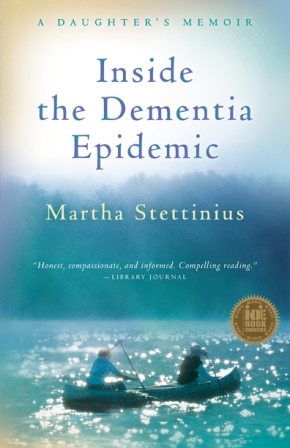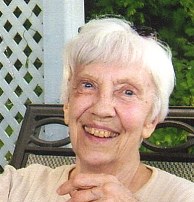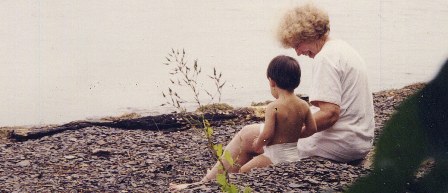Sample: Ch. 2: "The Decision"
A month before my mother drove into the ditch across from her doctor’s office, she had called him in a panic. She couldn’t remember if she’d recorded a certain check. Dr. Gavin and I both knew how meticulous she was with her checkbook. This incident upset her so much that she called me, too, which was also unlike her.
On the phone she told me that the previous night she had lost her bearing outside in the dark and almost stepped off a cliff. "And two weeks before that," she’d said, "I fell on my way down the hill from the car. I wasn’t hurt, but I’m scared. What if I fall again, Martha? What if I get confused again and walk off that cliff?" She confessed her concerns all at once, as if she could no longer hide them from me.
It was clear my mother could no longer live alone at the cottage. It was simply too dangerous.
What would be the alternative? Should I start commuting to care for her on a regular basis? I lived almost two hours away, round-trip. I worked. I had two young children. If Mom continued to live at the cottage, she would need someone to shop, cook all her meals for her, and clean. The cottage was five miles from the nearest town, which was too small to offer transportation services for the elderly, and few neighbors lived on the lake in the off-season to help drive her to appointments.
I thought of the access road down the cliff to the cottages. It was blasted perhaps a hundred years ago, with the narrow passage hugging the cliff at a forty-five-degree angle, and a hairpin curve halfway down the steep descent. Once in a while, the only other year-round neighbor plowed the road with his four-wheel-drive; but even then, most cars couldn’t make it up and down the road without threatening to slip sideways off the cliff. My mother had to park her car on a precipice five hundred feet up the road, and clamber up and down with her packages.
How had my mother managed this? Like a Nordic explorer, she wore ice cleats on her boots for traction and held a ski pole in her hand for balance. She baby-stepped up the hill to her car, then carried her groceries and library books back down in a red backpack. When she was younger, she pulled an improvised sled, a blue, plastic barrel cut in half with a rope attached.
For her to continue to travel to and from her cottage would tempt a deadly accident. What could I do?
I discarded the idea of commuting to drive her to and fro, or hiring aides to do so. Even at that starting point, I could see the potential problems with weather and no-show aides.
Maybe she could move in with me, my husband Ben, and our children? I assumed that it would be easier for me, less stressful, if she lived in our home where I could include her in our meals, help plan her activities, and attend to her other needs without driving. I imagined that having my mother live with us would be the easiest way for me to help her.
My family lives in an unusual, planned community, a development of more than thirty families on a large parcel of mostly open land. I imagined that, if my mother needed more company than I could give her, all I would need to do would be to walk across the gravel path that connects the houses and knock on a door, call someone, or send an email on the community's listserv.
I pictured Mom smiling and serene as she sits with a new friend at a concert at one of the three universities in town; joining us three nights a week for community meals; watching neighbors of all ages weave the cloth ribbons of our Maypole in the spring. I assumed that my role would be peripheral. Our community would give Mom the stimulation she needs to rejoin the pulse of life.
Most important, though, I wanted to protect my mother—keep her from falling or starving. She looked skeletal, and I wanted to feed her. In my home, I could tuck her under my wing as I would my children; I could send her out into the world but watch her.
I talked to Ben about her living with us. He has not had warm feelings for my mother since that night, early in our marriage, when she kicked us out of the cottage in a rage. Ben agreed to invite my mother into our home only because it was important to me.
I called Mom to tell her that it was too dangerous for her to stay at the cottage any longer, that she could live with us. I was sure she would balk. To my surprise, she seemed relieved.
She said, "You’re right, honey," her voice small and far away. "I don’t think I can do this anymore."
When we finally do reach Dr. Gavin’s office that February morning, I report the incident of the snow ditch. Mom is quite fond of the elderly Dr. Gavin, her "small town doctor," as she calls him, and has been going to him since she moved into the cottage.
He reads aloud what he records in my mother’s chart: "Judy’s daughter is uncertain at this time whether or not her mother should be driving."
Turning to Mom, he says, "I believe you may have had a very small stroke, Judy."
"I have?" Mom looks startled.
"Yes, I believe so. A very small stroke, too small to detect, but one that has affected your memory." He pauses. "You and I have both noticed some small changes in your memory, haven’t we?"
"Yes, I must say I’ve noticed," Mom says. "It’s very upsetting." She frowns but continues to study the doctor’s face.
Dr. Gavin asks, "Judy, could you tell me what you had for breakfast this morning?"
"I usually have ice water."
'And what did you have for lunch?'
"Crackers, I guess. I haven’t been that hungry."
"Did you know that you’ve lost fifteen pounds this past year? You’re down to 118."
"No, I had no idea."
She smiles and flutters a laugh, but I feel something chill crack. Ice water. She’s doing even worse than I thought.
I tell Dr. Gavin that I’ve invited my mother to live with me.
The muscles in his face relax. Slowly, as if choosing each word carefully, he says, "I think it would be…good…for you, Judy, to be with your daughter."
"Yes, I think so, too." My mother trusts her doctor. I know she trusts me, too, but Dr. Gavin’s opinion means just a bit more to her.
As I stride back down the hall with Mom at my side, I smile too much at the nurse and the assistants. I leave confident in my new role but puzzled by the doctor’s reserve and his sad eyes.
Read Chapter Twenty: "Slowing Down"
Read Appendix B: "Medications Approved to Relieve the Symptoms of Alzheimer's Disease"


















 Share Article
Share Article